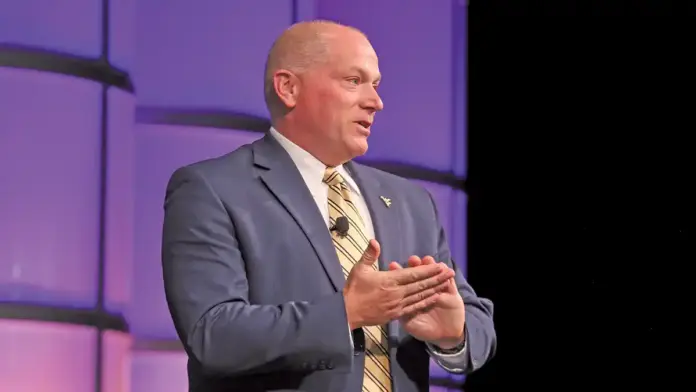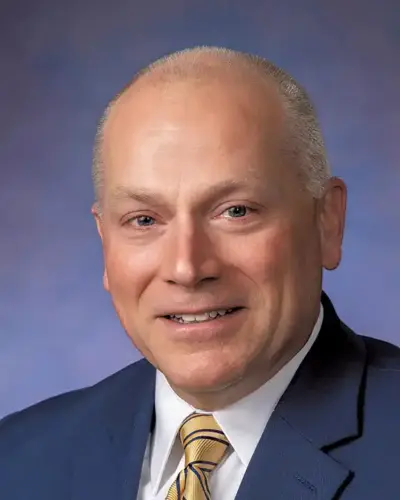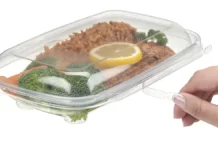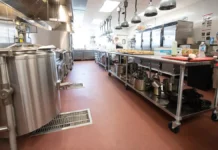
Last month, the School Nutrition Association (SNA) introduced Chris Derico, SNS, as the association’s president for the 2023-24 school year.
Chris Derico is also the Child Nutrition Director for Barbour County Schools in Philippi, West Virginia. He will now be representing SNA’s 50,000 school nutrition professional members nationwide.
Throughout his career, Derico has worked as an educator, administrator and child nutrition director, advocating on the importance of school meals to students’ academic success and wellness. He credits many of his leadership and communications skills to his side career as a high school basketball referee and NCAA basketball official.
With the new school year launching later this month, Total Food Service sought out Chris Derico to share his vision for where K-12 school foodservice is headed.
For those who don’t know you, can you share a little bit about your background?
First of all, I am an educator. I got a teaching degree and taught middle school math. I always knew I was going to go into administration. My father was an educator, school principal and central office administrator for many years, and I was following his footsteps.
And where did you grow up? Where are you from?
I am from almost where I’m at now, Weston, West Virginia. That was in the school district of Lewis County. And that is where I taught. I did go to a neighboring district as an assistant principal for three years, and was able to go back home after that at my high school where I graduated from. And was the assistant principal there for five years.
What punishment came about that you had to go into food service? (I’m joking)
Of course. Well, after five years, the Child Nutrition Director for our district was retiring. I always knew I wanted to be in the central office in some capacity, so when that opportunity came up, I seized it. I spent 17 years in Lewis County in the central office. Obviously, my responsibilities grew over those 17 years. It did start off just child nutrition, and evolved into almost all aspects of education, from curriculum at the secondary level, to a little bit of technology, to public relations, probably personnel a little bit.
My hands were into a lot of different things throughout the years there. It’s a relatively small district, when I first started in Child Nutrition, it was probably just a little under 3000 students at seven or eight schools. And before I left there, we closed a couple of schools. So, I finished with 4 elementary 1, middle 1 high schools, and around probably a little under 2800 students when I left there.

You know what’s interesting, I call it school food and you call it Child Nutrition. There’s a big difference in those two names.
Well, it’s funny, when I was young, probably going to school, we always used to call it a hot lunch. And that could have been referenced to breakfast or lunch, but we sort of just always called it a hot lunch. Through time, that term has evolved into if you’re talking about the whole program.
As you look at a snapshot, where do you see Child Nutrition today? What role does it play in education? What role does it play in growing students? Talk a little bit about what your vision is.
I’m an advocate believer that child nutrition plays a key role in the education of students. And I think a lot of educators know that but often overlooked. Obviously, hungry students who are wondering where their next meal is coming from, or what time it’s occurring, are not prepared and ready to learn. So once again, that Breakfast program, that lunch program that schools offer is a key component to making sure students are ready to learn each and every day. I believe that as an educator, and I believe that as a child nutritionist.
Do you think the importance of it is often overlooked?
I think sometimes parents and the greater community don’t understand how important that is. I believe the educators know that, but they get sometimes tied up in teaching their curriculum, they do forget it and overlook it day to day if you know what I’m saying.
I do. They just assumed that it is kids acting like kids, and in fact, it’s human beings that haven’t been properly fed.
Here’s a little joke in our industry if it’s a joke, but when it comes to state testing time, then the principals and teachers are worried about how we’re going to feed breakfast to the kids. The other days of the week, they don’t ask about it. They know how important it is, they just don’t think about it.
When you left administration, and you moved into child nutrition, what was it that attracted you to Child Nutrition?
First of all, I’ve always had a personal interest in wellness. I’m an active person, running, bicycling, and obviously, nutrition goes into that, I just have that personal interest. But once I got into the field, from an education standpoint, I realized the impact I was having. And the impact not only on the students, but the people working in the child nutrition industry, how I could work with my cooks, give them some training opportunities for them to shine, and I actually try to give them some rewards for the work they do each and every day, because it’s not easy work.
How did your operation change during the pandemic? As we’re into this new normal, what did you take away from that that you’ve kept?
Flexibility, first of all, because we all have to be flexible. And obviously, we all responded at different times during the pandemic, just making sure there was food available for our students, and looking at different delivery methods and so forth. And of course, without going into old topics, food supply was an issue, it still is today, definitely is not as bad as it was during the pandemic.
But there’s still a few challenges out there. Probably the biggest challenge, and you see it in your own home is inflation. The cost of our food, our supplies, equipment and so forth has definitely went up. So that’s a concern for us and our school districts. But once again, I think the focus is making sure we’re making food available for all of our students every day, I go back, it’s important for the educational component, but it’s also just important that we take care of our kids throughout West Virginia and throughout the country.
What got you involved with SNA? What led to that?
I should say, I’m aware that every profession has an organization. I’ll be honest with you, the first week of the job, I Googled it, found it, joined because I always believed in associations, I just thought it was the right thing to do. And then the leadership probably came because a colleague reached out to me and said, hey, it’s time for you to get involved, time for you to step up a little bit.
And obviously, it started off with what I would call a minor role, and as you can see, that role has increased through time, and as the President of the National Association now. I’ll be honest with you, at my age, and career and so forth, I think it’s important that I give back. I’ve always thought it was important to help others. And I feel this is a way in which I can help others.
As you look at your agenda as you take over the reins of the SNA, what’s on that agenda?
First of all, a personal thing is making sure that our people, people that work in the child nutrition business gets the recognition they deserve for what they do for educating our students. We’ve already spoken about that, but that’s just very important to me.
Obviously, something the School Nutrition Association has said for a long time, and we thought during the pandemic, we would love to somehow have free meals for all students. We see a lot of velocity with this, a lot of states are doing some laws that are actually somehow providing free meals within their own states. And if the federal government could somehow do that for us someday, we would love it.
In the years that you’ve been doing this, have you been able to see a move away from pizza, hamburgers and fries, in terms of getting kids interested in other things?
Our focus and my focus are two things. One, making sure there’s fresh fruits and vegetables available, whether that’s in a fruit and vegetable bar, or maybe something more of a salad bar, just making sure that if there’s pizza being offered today, there is all kinds of choices when it comes to vegetables and fruits, especially if it can be local, fruits and vegetables, it’s been a big push. And I’ve tried to push local.
The other thing I tried to do, I tried to showcase food that students maybe do not get at home, expose them to ethnic foods or just foods they might not be exposed to very much in their community here in North Central West Virginia.
Where are we with the CN programs that are out there right now? Any idea how that’s being dealt with? In other words, the regulations right now, are they fair with what’s out there right now? Are they livable? Where are we?
There’s a concern about the proposed regulations. There were some proposals put out back in the spring or a little before, comments were put out, the comment period was even extended. And there’s some concerns about the sugar regulations and how that would affect us. And probably the biggest concern is the sodium. Sometimes we feel we’re trying to make up for maybe the excess sodium students receive at home is all being made up into school meals, and that’s a tough pill to swallow. If we could have a little more flexibility with that sodium regulations, it sure would help us.
Is there still a viable subsidy program in terms of commodities? And what would you like to see as an association in terms of where that hits?
Well, once again, when it comes to commodities, West Virginia is a little unique because we do a state contract and I don’t have to do a whole lot with it. We fully support commodities and so forth. Sometimes the regulations that we have on obtaining those commodities, once again, gets into a little too much paperwork and hurdles to jump through. So, anything that would relax those regulations to make it better. And let’s face it, those commodities, that program began so we can help the local farmers, farmers throughout this country. And I think we are all for that, because that’s an important component here.
As an industry, you were Farm to Table or local to table long before it became a sexy topic.
That is correct. I love using my local farmers or even what I call my regional farmers. And of course, I’m in West Virginia, so my growing season is a little bit less than in the southern states. But when I can, I take advantage of some local farmers. And I think it’s good for my economy here locally to help out my neighbor so to speak, if that makes sense.
Of course, it does. Do schools have an obligation to lead the fight against obesity, or does this have to happen at home? Or do you have to have help at home?
How I answer that question, it goes back to what I fully believe as an educator. Many years ago, education was about teaching the three R’s, we taught that for many years. But today, we teach everything, I really think the school system has to have a holistic approach to educating children. When it comes to nutrition, fitness, wellness, that is part of that. Now, just like the rest of education, there is some responsibility outside of the school system at home, maybe with the community.
But once again, I think we have to embrace that part of our job as showing students, educating students on how to be healthy, how to be physically fit, how to be physically active, and also their diet and so forth. I actually think being physically active is often overlooked. It’s not talked about enough. It’s one thing to watch out our diet is but I think we need to be more physically active, including myself, and I tried to be.
So, off the couch with video games and onto some sort of a phys-ed program.
That is correct. And once again, phys-ed programs have been cut through time. And it’s a shame, it’s not really a side effect of child nutrition, but it’s a factor.
You recently had your annual convention and trade show in Denver. Can you talk about some of the highlights that came out of that event?
First of all, when it comes to that conference, the biggest highlights are the exhibit floor. There was over 800 booths that consisted of over 320 companies. And it’s always great to see anything new they may have, to see if there’s any new companies that I could utilize. I know there’s a lot of plant based in the world today. You see advertisements for plant-based products and so forth. So, we did have a lot of plant-based manufacturers there.
The other thing I like seeing is just maybe presentation, because a lot of times it’s about how we serve students. When you go to your convenience stores, it’s all about how it’s packaged and presented to you. And I think sometimes we’ve got to do something similar in our kitchens. We also had over 100 education sessions, where participants could go to their topic of interest and so forth. And last but not least, just networking. When you’re able to talk to a colleague in another state, and have conversations about how you do this, and you work through this, you take away a lot.
Anything on the equipment side like combi ovens that have caught your eye in terms of production of food?
Combi ovens are something I have purchased in a couple of districts I have been in. They’re great, because it takes care of the oven and the steamer. The challenge with the combi oven is obviously the learning curve. And one of my biggest hurdles, and I think a lot of people feel this way is training time with our staff. That’s something that’s not often thought of, and it’s often overlooked, but I just need training time for my staff. But combis are a hot topic. And we’re always looking for equipment that maybe just makes our kitchens more efficient and so forth.
With that, are you concerned with the ability to attract people coming forward to work in child nutrition?
I think it’s fair for me to say that a lot of people are having trouble finding people to work. It’s no different in education. We’re struggling with finding teachers, custodian secretaries, and likewise, I’m struggling to find cooks. I don’t have an easy solution. I know we didn’t used to have to recruit. But I feel like we are now reaching out there, and we actually are actively recruiting in all those positions, including cooks. So yeah, that’s a concern.
Any committee working on that? Any concrete recruiting plans as an association?
I don’t know from an association standpoint, I know from my district standpoint, we’re looking at going to college fairs, and so forth. And we’re also just doing a lot more promoting on our social media and our website, hey, come work for us, here’s some of the benefits, sometimes our pay is not the best, but we do have some positives to these things.
You’re out of there at 4 o’clock, you can have a life, there’s a lot of positives to it all.
You’re off on the weekends, you’re with your children for holidays, and that kind of thing.
When we talk a year from now, you’ll have a very different look at it, I’m sure. What does the future look like in terms of the next generation of leadership? What do you see?
I’ll tell you one thing I feel, and I hope this doesn’t reflect my age, I feel like there’s a lot of younger people becoming child nutrition directors earlier in their career. And I actually welcome that, because sometimes they think a little bit differently, they think outside of the box that I’m used to. I think they’re willing to take some challenges that maybe older people like myself aren’t willing to take.
And I think that helps everyone. And I’d say something else that the SNA has been working on is we’re trying to make sure our board, people involved in leadership positions with committees and so forth is diverse. We really want to make sure we get input from all types of people, young, old, etc., just so we’re getting input from everyone.
As you look into the crystal ball, what changes do you hope that you will be able to make?
Well, I don’t know how measurable this is, but I would like to hope a year from now, I can be very happy with the feeling of how important child nutrition is when it comes to educating students. That both principals, teachers and the greater community really recognizes the role that the cooks and cafeteria managers and others play when it comes to education.
To learn more about the current events and agenda for Chris Derico and the School Nutrition Association, visit their website.

























